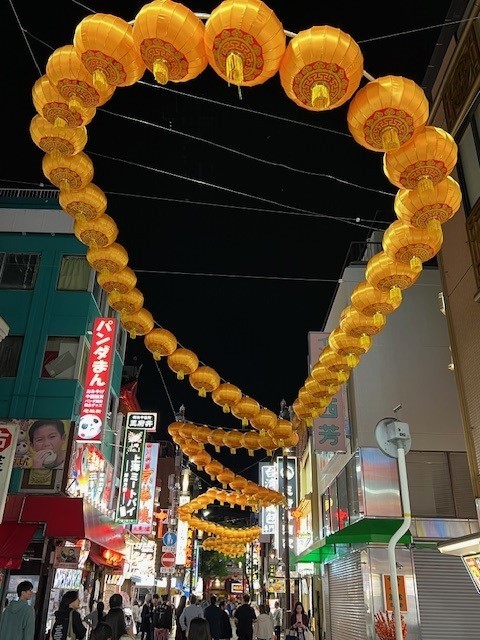0.0 rating based on 1 rating Sailed on Oceania Cruises-Regatta from Yokohama to Singapore Oct 29 to Nov 16, 2024.
Travel certainly is a curious part of human nature as wherever we go, we meet people living varied lives not too unlike our own. Except of course the culture, cuisine and customs, often determined by climates, making each destination unique. Which is why since the infancy of tourism in the mid-1800’s we all appear to have a never-ending curiosity to explore new places, whether near or far.
In late October 2024 my wife and I flew nonstop to Tokyo on Japan Airlines with a prearranged private transfer to Yokohama, 95 km south. Spent two nights in this pleasant city before boarding the Regatta of Oceania Cruises (see comments on the last page) - destination Singapore.
<><><><><><>
First, we visited five Japanese ports of call. Shimizu (famous for its iconic beach view of Mt. Fuji), Kobe, Hiroshima, Miyazaki, Ishigaki, and then southwest to Keelung in Taipei, onto Hong Kong and finally the cities of Nha Trang and Saigon (Ho Chi Minh City) in Vietnam before disembarking in Singapore. My impressions of this cruise will be focused on Kyoto, Hiroshima, Hong Kong, Saigon (Ho Chi Minh City) and Singapore, followed by comments on our cruise ship.
Japan in 2025 is scheduled to be one of the top ten most visited countries globally and in just a day it is possible to experience the tranquility of life here and appreciate why. Of course, the larger cities are bustling, but more so with pedestrian than vehicle traffic. As almost 75% of Japan is mountainous so flat land is precious. Starting in 1989 multi-level roads and freeways were built crisscrossing the cities, more often on the outskirts so they did not isolate communities on either side of the roads. As most roads offer parallel lanes, parking a car is solved by multi-storied parkades. At times one can look down roads and hardly see any traffic, hence the calming effect on lifestyle here. With less than 3% foreigners living in Japan (versus almost 15% in USA, 11% in the UK) this country maintains a lot of traditions and festivals and ensures historical buildings and castles are well kept. In a nutshell Japan is very Japanese.
<><><><><><>
We arrived in Yokohama three days (2 nights) before the cruise to adjust to the time zone, staying at The Rose Hotel (https://www.rosehotelyokohama.com/en/), adjacent to the very colourful Chinatown. We had stayed at the same hotel a decade earlier on our previous circumnavigation of Japan cruise visiting Nagasaki where our cruise ship the Diamond Princess was built. That was the city that suffered from the second atomic bomb explosion; on this cruise we visited Hiroshima, where the first atomic bomb fell. We took ship tours in several of the ports which were in the main very good. Our philosophy when travelling is if you view a port just from the streets near the quayside, it’s rather like taking a book from the library and never really reading it!
<><><><><><>
The cruise started with a visit to Shimizu where on the wide sandy beach adjacent to Sunpu Castle Park, one can view the iconic Mt. Fuji. Onto Kobe, the port city for Kyoto and Osaka. Having visited the Golden Pavilion in Kyoto many years ago we took a tour instead to the grounds of Osaka Castle Park.
The name Hiroshima speaks for itself and but for one iconic building that has been left as a reminder of the ultimate destructive powers of the human mind, you would be hard pressed to compare the photos inside the Hiroshima Peace Memorial Museum with the bustling city outside. In the morning a torrential rainstorm darkened the skies, almost matching the somber black and white photos inside documenting the destruction and aftermath, both physically and geographically. The full day tour included an afternoon visit to the island Miyajima (via a ten-minute ferry) to view the Itsukushima Shrine. Fortunately, the skies cleared and offered great opportunities for photographic memories.
Our final Japanese port was Ishigaki one of 160 islands in the Okinawa group due southwest, in a sub-tropical area and oh so very different from mainland Japan.
<><><><><><>
A day at sea across the East China Sea to visit Taipei and the port of call Keelung due west in Taipei. As in many Asian ports, powerful broad beamed tugboats whenever assisting cruise ships spread a white “apron" across the bow to avoid blackening the cruise ship’s hull. This unique courtesy I have never seen elsewhere around the world.
Sailing due southwest we arrived 36 hours later in Hong Kong. One of my favourite ports I often visited when I worked on board P&O’s iconic ocean liners (1968-1979) in the Purser’s Department (now known as Hotel Management). For over a century since 1845, well before the jet age, it was the only way to reach the Orient. Naturally the skyline has changed dramatically but the iconic green and white Star Ferries still remain, crisscrossing the harbour dozens of times daily on the mainland of Kowloon to Hong Kong Island. Ride on the top deck for just C$1.00 (HK$5.00). Nowadays two tunnels offer alternatives with private cars paying HK$20.00, still a bargain.
On the Kowloon side the cruise ships still tie up at the Ocean Terminal (this hasn’t changed since the 1960s) and few hundred metres away the former Kowloon-Canton Railway Clock Tower. One of the few historical structure's worth photographing in a city of skyscrapers.
<><><><><><>
Finally setting a course south by southwest to Vietnam and two ports of call, Nha Trang and Ho Chi Ming City, still more popularly known as Saigon. We picked up our pilot the previous evening at 2000 hrs., taking almost ten hours to navigate the 80 km northwards on the Saigon River before reaching the capitol at dawn. We have never experienced a more winding river in all our travels.
Wherever we travelled in Asia we noticed buildings with amazing designs, taking advantage of modern technology. Particular attention is paid in Asia to the very top to ensure that the unsightly elevator housing shafts are creatively hidden out of sight. On an all-day coach tour beyond the capital, I took in the buzz of the city, with motor bikes in dedicated lanes often outnumbering vehicles twenty to one. This city’s traffic lights had unique count down times from 90 seconds to zero. When the lights turned green the bikers took off like a shot! Less than an hour away from the city and the horizon rapidly changed. Farming in Vietnam still covers 39% of arable land and almost 43% of the population still work it. At this time of the year the second growing season of rice was well under way. As we sped alongside paddy fields, they looked like vast rich green manicured lawns stretching for kilometres on either side.
<><><><><><>
We departed at noon the following day, this time taking less than seven hours to cover the same distance as the pilot and Captain could more easily navigate the river activity in the daylight. Numerous gravel laden motorized barges crawled across the river and due to strong tidal movements, they could not change course, so our timing to pass these was everything. In less than two generations (from 1975) the city’s skyline is starting to mirror many neighboring capitals. The Landmark 81 Skyview (so named as it has 81 floors) dominates the skyline at 462 metres. It is around 80 km from the Saigon to the mouth of the South China Sea and as our ship weaved around countless bends on the Saigon River, the same building was still visible hours later.
<><><><><><>
Our cruise finished in Singapore where we spent three nights at The Clan Hotel Singapore (https://www.theclanhotel.com.sg/), enjoying dining on the 4th floor, and relaxing on the 30th floor with its spectacular views and open-air infinity swimming pool and jacuzzi. As we have visited Singapore three times before we opted for a Hop On / Hop Off bus tour of the city that provided 18 stops. As our bus tour was in the morning (always the hottest) we hopped of at the National Museum, appreciating some air-conditioned relief!
<><><><><><>
In closing details of our Oceania Cruises ship the REGATTA, one of four identical ships. It is pleasantly sized (30,000 tons), designed in a calming style where any point of interest is just an easy stroll away. Although she is a small ship in comparison to her competitors, still able to offer so much like the Aquamar Spa and Vitality Center, fitness classes, strolling and running track deck, talented guest entertainers, vocalists and casino. Two open seating eateries plus two specialty restaurants with eight lounges and bars. Almost 70% of the staterooms offer private verandas, with some 400 crew to serve 670 guests.
Her identical sister ships are the Insignia, Sirena and Nautica (30,277 tons). Oceania Cruises fleet now includes the mid-size ships (67,000 tons) of Riviera, Marina, Allura and Vista.
<><><><><><>








